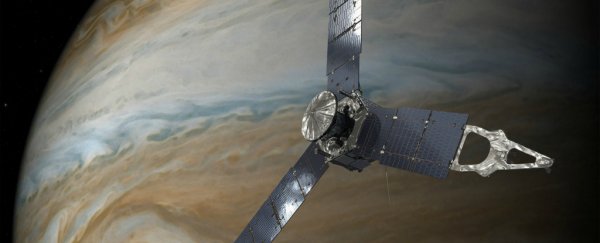NASA's Juno spacecraft unexpectedly entered 'safe mode' on Tuesday night, 13 hours before its latest flyby of Jupiter.
The spacecraft has been in orbit around the gas giant since July 4, and because of its elliptical orbit, it only gets close enough to take detailed scientific measurements every 53 days. But during this latest flyby, something caused all of Juno's instruments automatically shutdown, which means no data was collected, and NASA is still trying to work out what went wrong.
At a press conference on Wednesday, Juno principle investigator Scott Bolton said that they think the shut down might have been related to a software problem that told the spacecraft's computer to reboot because it "detected a condition that was not expected".
It's not yet clear what that unexpected condition might be, but NASA doesn't think the problem was related to the high radiation levels and magnetic fields around Jupiter - which the first flyby on August 27 revealed were more powerful than we'd originally thought.
"At the time safe mode was entered, the spacecraft was more than 13 hours from its closest approach to Jupiter," said Rick Nybakken, Juno project manager. "We were still quite a ways from the planet's more intense radiation belts and magnetic fields."
When one of NASA's probes enters safe mode - something that also happened to the Curiosity rover earlier this year - it basically means that all "unnecessary subsystems", including scientific instruments and cameras, are turned off, and the spacecraft or rover points itself towards the Sun to make sure it gets as much power as possible.
Juno is now awaiting further instructions from NASA, which says the system has now rebooted, and they're working on recovering the spacecraft's usual level of functionality.
This is actually the second issue for Juno in the past week. On Friday, NASA announced that it was going to delay changing Juno's orbit - something that it had scheduled to happen this week during the flyby, in order to put the spacecraft on a shorter 14-day orbit around Jupiter.
The change in plans was due to the space agency discovering that a couple of the valves in Juno's engine weren't behaving as expected, so they're postponing until they can get everything back on track.
The good news is that the spacecraft's onboard computer is now successfully back online and it looks like it should make a full recovery.
The bad news is that every flyby of Jupiter is a chance to get more tantalising data about the mysterious planet, its atmosphere, and its inner workings - and we just totally missed out on one.
But don't feel too bad - during the first flyby on August 27 we already managed to collect a whole heap of fascinating data, providing researchers with the first glimpse up to 400 km (250 miles) below the swirling clouds that cover the planet.
"With [the data], it is as if we took an onion and began to peel the layers off to see the structure and processes going on below," said Bolton.
"We are seeing that those beautiful belts and bands of orange and white we see at Jupiter's cloud tops extend in some version as far down as our instruments can see, but seem to change with each layer."
The next close flyby is scheduled for December 11, and hopefully all science instruments will stay up and running.
